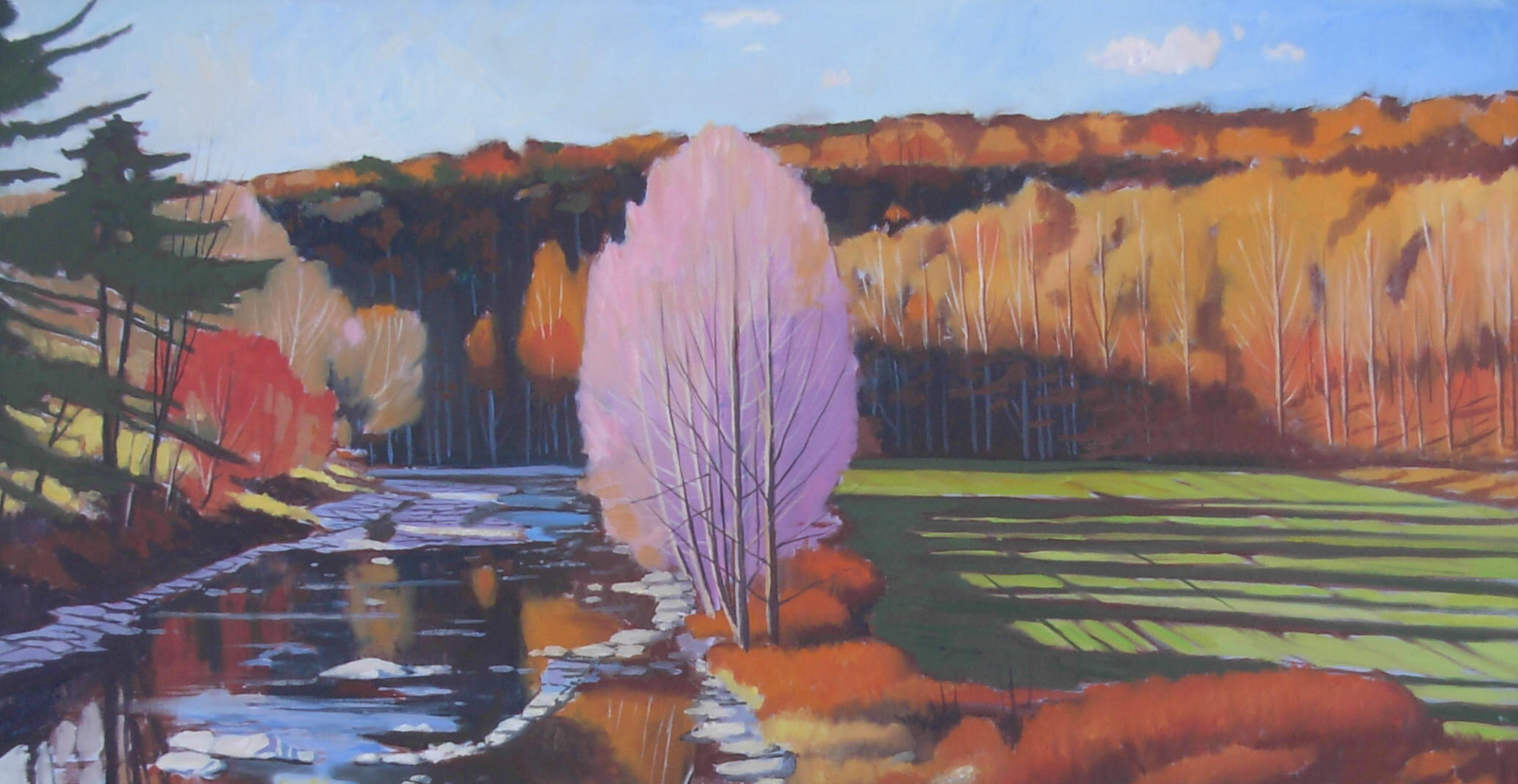
Municipal Help
Wyalusing Creek, October Light
Brian Keeler Studio, www.briankeeler.com
The Industry Approaches. What do you do now?
Establish a Home Rule Charter to decrease risk from state pre-emption. Information has been developed by the Community Environment Legal Defense Fund (CELDF).
Correct vulnerabilities in your zoning before the industry comes knocking. Do you have an industrial-zoned area? What industry would you like to see there?
Get your nuisance and safety ordinances up to date (noise, lights, etc.).
Enact set-back requirements for polluting and hazardous industries. Please see information about set-backs under the tab, Bucolic Bradford County.
A Right to Clean Air and Pure Water, Environmental Integrity Project, 2020. This survey explores municipal governments and their authorities with respect to the zoning and approval of oil and gas uses in Pennsylvania.
Scenic Byway. Work with adjacent municipalities to designate a stretch of roadway as a Scenic Byway. This designation will not stop traffic and polluters, but it could help you, should DEP ever adopt an environmental assessment for gas-processing facilities. https://www.penndot.gov/ProjectAndPrograms/Planning/Pages/BYWAYS-Program.aspx
The Industry Approaches. What do you do now?
Pennsylvania Citizens Toolkit, Environmental Integrity Project. https://environmentalintegrity.org/pennsylvania-citizens-toolkit/
The industry will be talking about their solution to the problem of “stranded” gas. Stranded gas isn’t a problem. It is simply an industry term that means that gas is not connected to a pipeline to get it to market.
Reach out to your neighboring municipalities. Plan a meeting to include voices from other municipalities.
Make the project’s evaluation about more than just zoning.
Consider the impact on schools and senior-care facilities that are outside your municipal boundaries.
Consider the impact of the project on small businesses and the wider public, not just landowners with gas rights.
Ask politicians who have received contributions from the gas industry to recuse themselves from the discussion.
Ask questions and get answers in writing. Note which questions do not get answered.
What is the life of the project? What is the year-by-year project timeline over the next ten years?
Will any of this LNG be used for PA power generation? Where?
Will any of this LNG be used for out-of-state power generation? Where?
Will this LNG be exported? To where?
Will this LNG be exported to the spot market?
How much insurance will you carry for accidents at the site? Could we see a model policy from the insurance carrier you expect to use?
How much insurance will you carry for to cover accidents along the approximately 200-mile haul route? Could we see a model policy from the insurance carrier you expect to use? Could we see the liability coverage of the HAZMAT carrier that you expect to use?
Where will the gas feed-stock come from? Who have your contracted with to do the fracking? Please provide a map with a radius of the expected fracking over the next ten years.
What additional gathering lines will be built? Who have you contracted with to construct the gathering lines?
Will you be connecting to an existing pipeline? Which one? Where will the connection be built?
Will the footprint of this project (fracking, gathering/pipelines, trucking and rail) go beyond the County? Which counties? Have you notified them? May we see the correspondence?
Could the project change from liquefied natural gas (LNG) to compressed natural gas (CNG) to natural gas liquids (NGL)? *
Could the project send gas to an interstate pipeline?
Where will you dispose of construction waste?
Where will you dispose of fracking residual waste?
What is the expected level of noise and plan to control it?
How much light pollution will be created and what is the plan to control it?
Will you be monitoring air quality at the nearby schools?
What is the plan to dismantle the plant, after it is no longer in use?
Document all conversations and save all emails. Once word gets out about the project, you as municipal officials want to exemplify upstanding representation of public interests.
What if you are a municipality along the LNG haul route?
Safety and Emergency Preparedness: Immediately contact your county emergency preparedness coordinator. As a county, approach the industry to ascertain the haul route and preparedness costs and obligations of the industry.
Does the motor carrier of the HAZMAT have liability insurance? This is an area that you may want the municipality legal counsel to look into.
Demand that the industry cover the costs for traffic engineers to plan evacuation routes and signage.
If the industry offers you a fire truck, realize that it is a false salve: A boiling liquid expanding vapor (BLEVE) fire cannot be extinguished.
Truck Traffic
PennDOT probably cannot implement truck restriction unless there is a history of issues.
Lewisburg, PA is an example of a community taking action to address concerns that large trucks were hurting its downtown businesses.
Monitor Fracking Activity
The FracTracker mobile app allows for upload of field reports and photos concerning activities of the natural gas industry. If something doesn’t look, sound, or smell right, upload a report. They are geolocated and dated and app users can add their own field notes.